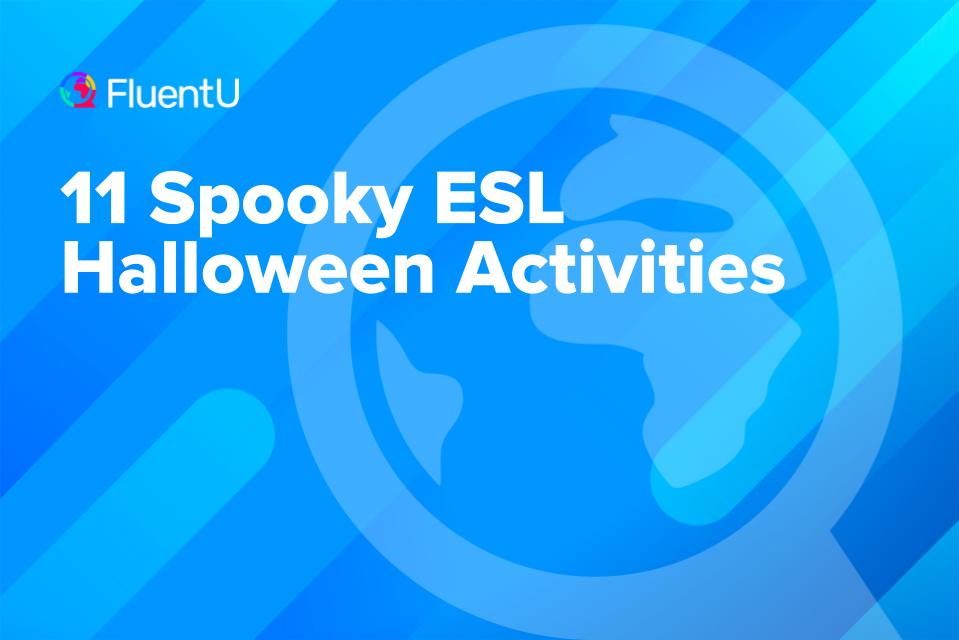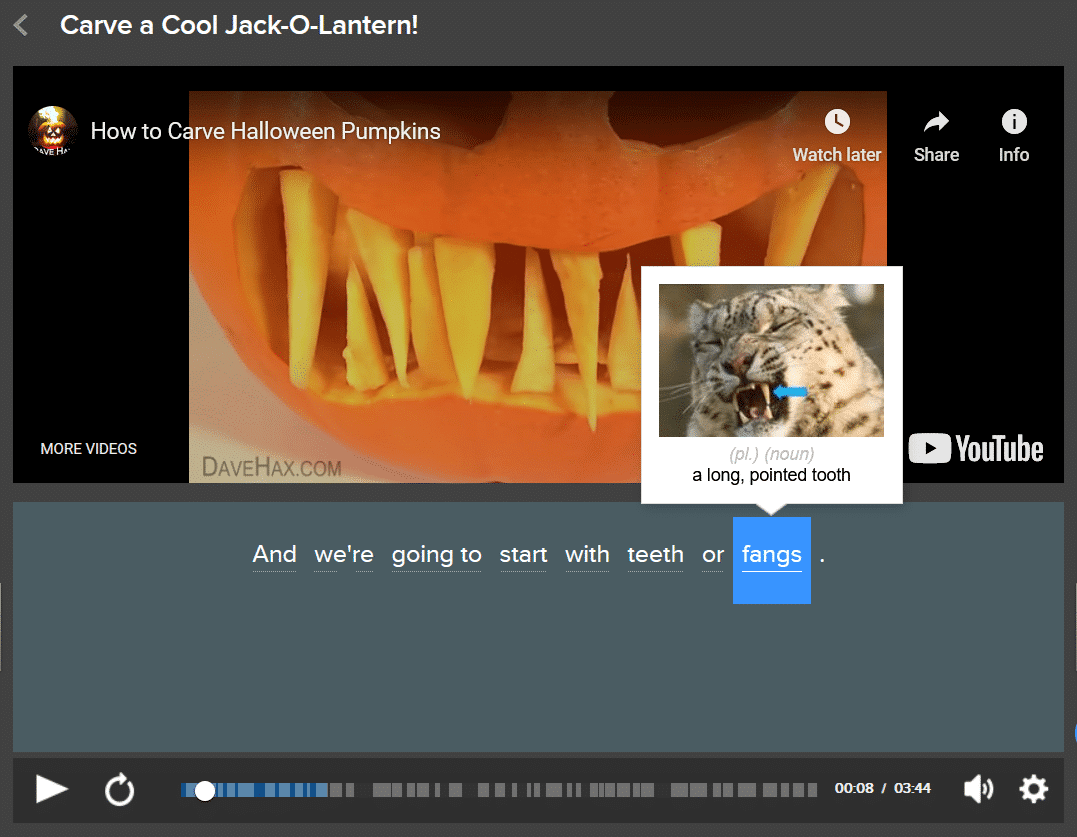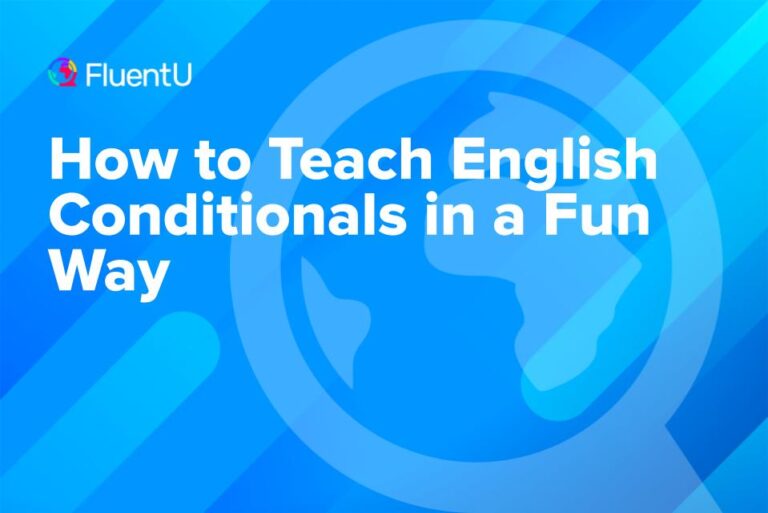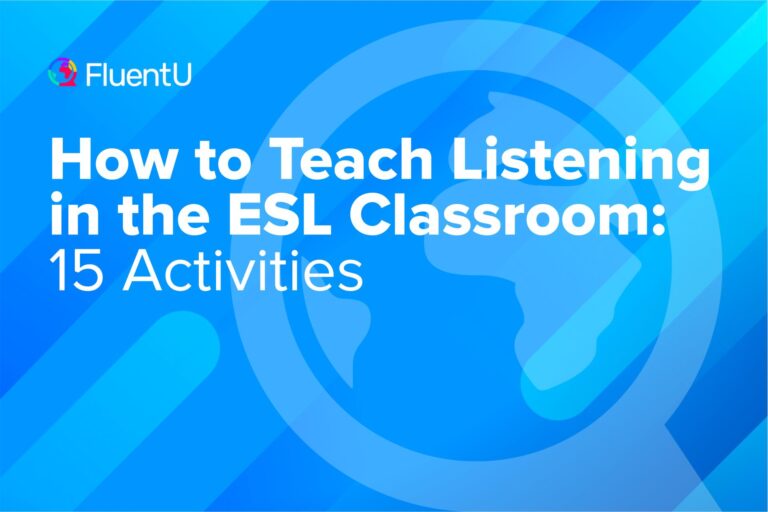11 Spooky ESL Halloween Activities

For some ESL students, this will be their first introduction to the late October holiday. It’s always fun to share a little with students from around the world about how the holiday is celebrated in America.
But Halloween fun can be a learning tool, too. Here are nine ESL activities you can do with your class that will both build their language skills and give them a little spooky excitement too.
Download: This blog post is available as a convenient and portable PDF that you can take anywhere. Click here to get a copy. (Download)
1. Writing Scary Stories
Writing stories is a good way to practice verb tenses and become comfortable with using descriptive adjectives.
In this activity, you can give students a structured writing exercise that’s both fun and challenging at the same time.
Lesson Procedure:
- First, ask your students to brainstorm Halloween vocabulary in groups.
- Give out 15 small slips of paper to each group and have them write one word on each slip. Every group should have five slips with nouns, five with verbs and five with adjectives.
- Once all groups have written their words, collect their papers and switch them between groups, so each has a new set of words.
- Together, each group must use these words, as well as some of the Halloween vocab they’ve written, to write a short story.
- At the end of the lesson, have people present their story to the class.
2. Fright Night Stories
A lesson in which you tell your students a few scary stories in the dark will help build their listening, discussion, prediction, writing and reading skills.
If you need some inspiration, the Huffington Post has a list of terrifying ghost stories you can use. Here are a few more that work really well.
To make things even spookier, you can screen some Halloween clips from the FluentU library. FluentU takes authentic videos—like music videos, movie trailers, news and inspiring talks—and turns them into personalized language lessons.
Since videos are supported by interactive subtitles, your students won’t have any issues with keeping up, no matter what level they are.
You can request a free trial to explore how FluentU can add an immersive and native component to your class.
Many different countries have their own variations of these stories, so this is the perfect opportunity to explore them. Ask your students to describe different ghost stories they know. You could even have them write these out and present them to the class.
Lesson Procedure:
- For this activity example, we will use “Tap, Tap, Tap.” Have your class sit in a circle, and tell the story from the center.
- Stop halfway through the story and ask your students what they think will happen next. Have them pass the flashlight around while explaining their predictions.
- Make sure to add sound effects! There are many instances where you can use sound effects to make the “Tap, Tap, Tap” story more horrifying.
- When finished, turn on the lights and instruct your students to craft their own ending. This could be based on their predictions, or any other creative ideas they might have.
- Afterward, students can share their stories with the class. Set the Halloween scene again by turning off the lights, turning on the spooky lamp, and passing around the flashlight.
- The end of the lesson is a fun time to really discuss each other’s scary endings: Who liked what? Which characters were more scary?
3. What Monster Am I?
This lesson is perfect for implementing collaboration, listening and reading skills, as students will compete in teams to earn points. You’ll need to create 10 descriptions of various monsters ahead of time.
For example, a description of Dracula might look like this:
I don’t sleep much at night and enjoy a cool dark place to sleep. I have sharp teeth and dislike Italian food because one ingredient disagrees with me. I have a hard time seeing myself and I was born in Eastern Europe. What monster am I?
Each team will read these descriptions aloud so their teammates can guess which monster they’re describing. The students reading the descriptions will not be allowed to use any monstrous movements to help their teammates guess.
Lesson Procedure:
- Divide your class into two teams.
- Have Team A choose a representative to read the first monster description you give them. Only readers can see the content, so listening skills play a major part in this activity.
- The team members from Team A will collaborate and get one guess.
- If Team A guesses the correct monster, they get a point. If they guess wrong, Team B gets a shot at guessing.
- The team with the most points wins!
4. Ghoulish Idioms
Even though the English idioms involved in this ESL activity are geared towards Halloween, they have practical use year-round as well. This lesson promotes collaboration, communication, grammar, reading and understanding idioms.
First, you will need to develop a few ghoulish idioms for your students to use during the activity. Here are a few great examples:
- Blind as a bat
- Dig your own grave
- Pale as a ghost
- Skeleton in the closet
Once you have 15 to 20 idioms, print out the list and cut them into strips such that there’s one idiom per small slip of paper.
You could put all of the meanings on a single worksheet and make copies, or create a PowerPoint that has three or four different meanings per slide. During the lesson, students will have to match the idioms to their meanings, so you can set up the activity however you want it to run.
Lesson Procedure:
- Divide your students into small groups or pairs, depending on class size.
- Give each group a slip of paper containing one of your Halloween-themed idioms.
- Your student teams or pairs will read the idiom and the several choices of meanings (on a worksheet, PowerPoint presentation or another mode). Only one answer is correct.
- Each team or pair that chooses the correct meaning of their idiom gets a point. The lesson continues until there are no more idioms left.
5. Monster Charades
Monster charades is somewhat similar to the “What Monster Am I?” activity. The only difference is that your students will use actions as their monster descriptions instead of words.
The ESL skills integrated into this activity include collaboration, description and quick English thought.
Lesson Procedure:
- Divide your students into two teams.
- On every turn, each team chooses a teammate who will act out a specific monster.
- Team A goes first, with their team representative standing up in front of both teams.
- Give the student a card with a monster/Halloween character, and the actions needed to create a descriptive pantomime. For example, Frankenstein’s monster has a very unique walk, as do zombies, and these are the actions the students can perform.
- As the student from Team A begins acting, Team A watches and discusses together what monster/character it is. They have only two guesses as a team before Team B gets to take a stab at it.
- Keep alternating turns between Teams A and B, continuing until class time runs out.
6. Classroom Haunted House
This Halloween ESL lesson will transform your classroom into a haunted house. Everyone likes a good Halloween scare, so what better way than to have one or two in a haunted house?
Having your students create ideas and transform their classroom into a haunted house is a great way to connect culturally, while having fun and learning essential ESL skills. This lesson promotes planning, discussion and vocabulary, as well as having total physical response (TPR) elements.
Lesson Procedure:
- First, it’s vital for everyone to understand the concept of a haunted house. Watch a video about one and discuss the details. (Here’s a really neat video that goes behind-the-scenes of a haunted house.)
- Have a brainstorming session. Ask your students what their haunted house should have and where each area will be within the classroom. Write down their frightening thoughts on the board.
- Divide the work into groups by assigning each group to a specific section of the haunted house. This will promote TPR learning as students begin to move about into their specific areas.
- Once students are in their designated areas of the classroom, hand out the boxes of materials they can use to create their section of the haunted house.
- Parents are also great for haunted house spectators once the project is complete. You can also invite other classes or teachers to go through your haunted house!
7. Explore the History of Halloween
Provide a worksheet with a passage about the history of Halloween and how it’s celebrated.
History.com has a history of Halloween pages you can use. Allow some time for your students to read through it, having them highlight any words or sentences they don’t understand, then provide some questions to make sure they’ve understood it.
You can use Breaking News English’s 100 Halloween Questions to wrap up the class and give students a chance to practice speaking. Some of my favorite questions to get the students talking are:
- What is the best Halloween food?
- Where in the world do people have picnics by the graves of relatives?
- Do you believe in ghosts?
Lesson Procedure:
- Hand out a printout of the History.com page on the history of Halloween.
- Give students some time to read through the printout, noting or highlighting any words and expressions they don’t understand.
- Go over the worksheet in class, giving definitions and examples of the unfamiliar vocabulary.
- Have a class discussion about the history of Halloween. This is a good chance to bring in your students’ cultures. Ask them to share some superstitions and cultural similarities (or differences) between their cultures and Halloween.
- Finish off by pairing students off and giving them a list of questions about Halloween to structure conversations around.
8. Do Some Halloween Crafting
Halloween lessons don’t always have to be about speaking English. They can also be a chance to simply have some fun!
There are lots of different crafts you can try. Have your students carve jack-o-lanterns, make origami trick or treat bags, design their own costumes or even cook some Halloween-themed treats.
Parents.com has lots of Halloween craft ideas, and each one has an instructional video you can use for your class.
Not only will arts and crafts be a fun break from textbook activities, they can practice English by listening to your instructions.
Lesson Procedure:
- Choose a Halloween craft to do with the class. It should be age-appropriate, simple enough for any level of student and based on materials that you can easily acquire for an entire class.
- Hand out the materials to the students, along with a sheet of instructions.
- Go over the instructions as a whole class, making sure everyone understands what to do—and what not to do!
- Encourage students to talk among themselves in English as they complete the craft.
- After everyone is done, ask for some volunteers to show their craft to the class and talk about what parts they enjoyed or had trouble with, or simply ask them to describe their finished craft.
9. Candy Taste Test
Who doesn’t like an excuse to eat candy in class? Halloween is the perfect time of year to host a candy taste test with your students. Bring in three different types of Halloween candies for students to taste (allergies permitting).
Lesson Procedure:
- Before starting the activity, review with your students how to form comparative and superlative adjectives. Then let each student try each of the sweets you brought in.
- After tasting each candy, your students should make notes about how it tastes. For example:
This one tastes sweeter than the first.
This candy is the hardest.
- This is a good time to remind students of adjectives that describe flavor.
- Once they have tasted and described each candy, students write a paragraph saying which candy was best. They should use comparative and superlative adjectives to support their opinions in the paragraph.
10. Halloween Scattergories
This classic game is great for teaching ESL students new and less common vocabulary.
Lesson Procedure:
- Start by brainstorming a list of things associated with Halloween (i.e. candy, monsters, costumes, etc.). These will be the categories for the rest of the game.
- From your list, choose the six best categories. Then roll a letter die or choose a letter of the alphabet at random. (Avoid less common letters such as x, q, v, j, etc.)
- Then give your students one minute to think of a word that fits each category and that starts with the letter you rolled. For example, for the letter “D,” they might answer something like “candy: dark chocolate, monster: Dracula, costume: dog.”
- Have students share their answers with the class and cross out any repeats to get their score for that round. Play three rounds with three different letters. The person with the highest score for the combined rounds wins a Halloween prize.
11. Halloween Tongue Twisters
Tongue twisters are fun to do with ESL students. Just about anyone likes the challenge of pronunciation acrobatics, and it’s easy to tailor them to Halloween or any other holiday.
Lesson Procedure:
- Start by explaining that tongue twisters are pronunciation challenges that use the same or similar sounds in short phrases or verses.
- You might want to give your students a few classic examples such as “red leather yellow leather,” “rubber baby buggy bumpers” and “how much wood would a woodchuck chuck if a woodchuck could chuck wood.”
- Once students get the idea, challenge them to write their own Halloween tongue twisters.
- As a class, brainstorm some words associated with Halloween, like “goblin,” “monster,” “ghost,” etc.
- When it’s time to write the tongue twisters, start with a spooky Halloween term and add words with similar sounds to make a phrase. You can use the following examples or write your own.
Glowing ghosts gobble goodies.
Warty witches wish for watches.
Big bats match hats.
Musty mummies make monster masks.
- Celebrate your tricky phrases with a reading contest in which each person reads their tongue twister for the class–five times fast, of course!
Holidays offer excellent opportunities for your students to learn new cultural themes and new vocabulary, all while having fun.
These Halloween lessons are also great for promoting communication between students. They’ll see a different cultural aspect through holiday-themed lessons that will get them ready for more practical skills down the ESL road.
Download: This blog post is available as a convenient and portable PDF that you can take anywhere. Click here to get a copy. (Download)








